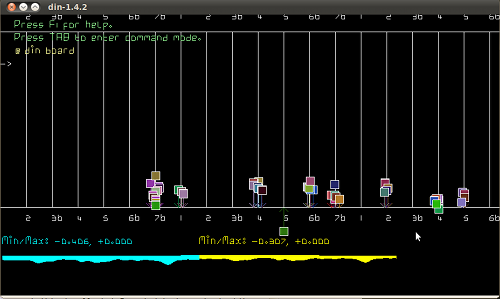Linux Audio: Din
There is no escape from Linux Audio, is there
9 February, 02011
Just as I was preparing myself to write a sad article, the title of which was already forming along the lines of "The end of my Linux Audio Quest", in which I planned to tell that musically I have moved back to Windows and FL Studio; just as I was thinking over the exact wording of the conclusion I came to after thoroughly exploring the world of Linux Audio for more than a year (and what a year it was!), just as all of that was going on, the situation has drastically changed.
The change occured one winter morning, when, drinking my morning tea, I was chatting with my good friend Michael, discussing rough edges of free software and other problems of universal scale, and in passing he threw me a link to some synthesizer.
I did have lots of plans for that day, you know. But they all got scrapped and next 7 hours I spent somewhere between imagination and meditation.

Din turned out to be much more than a synthesizer. In fact, I cannot think of it neither as a "synthesizer" nor as a "tool". To me Din is an "instrument". A unique electronic instrument which embodies tradition and modern technology into one, by its own existence making a point that history is not a series of separate events, even if connected by causality, but one reality.
Let's look at how Din works.
Basically, Din consists of roughly two parts - a resonator and drones. Resonator is a mono sound and is typically used to play a lead, each drone is also a mono sound, but the amount of drones is not limited.
The display shows a note grid, a table with white borders. By moving the mouse cursor over the note grid, you make resonator play. Moving the cursor along x axis changes the pitch, movement along y axis changes volume. Exact notes are horizontal lines, each note is pixel wide, the rest are microtones between notes. Note that you do not have to press any keys, resonator will play as soon as you move mouse over the note grid.
By using a key on your keyboard, you can also place drones in any location of the note grid. The taller the drone is, the louder it sounds. By creating whole clusters of drones, you can create an ultimately rich dronescape. You can then select the already placed drones and drag them around in real time.
This alone would be interesting enough, but there is even more. Resonator and drones are synthesized from inside Din by drawing Bezier curves, which basically allows you to create a waveform of any complexity. There is a default library of 63 waveforms which you can choose from and you can add your own to the list. Built-in gater and stereo delay with adjustable parameters, gater applies to resonator only (gate envelope available), stereo delay applies to both the resonator and the drones. And if that is not enough, there is also automation of parameters and automation of the resonator, so that you can literally record your playing and then put it on in a loop.
I did not describe everything. Din is a very deep instrument. You should dive in and explore yourself, because Din is much more about self exploration than anything else. Just like a flute, a percussion, a guitar, Din is something I think a musician can identify himself with:
"-What instrument do you play? -I play Din."
And yes, apparently there is no escape from Linux Audio :)